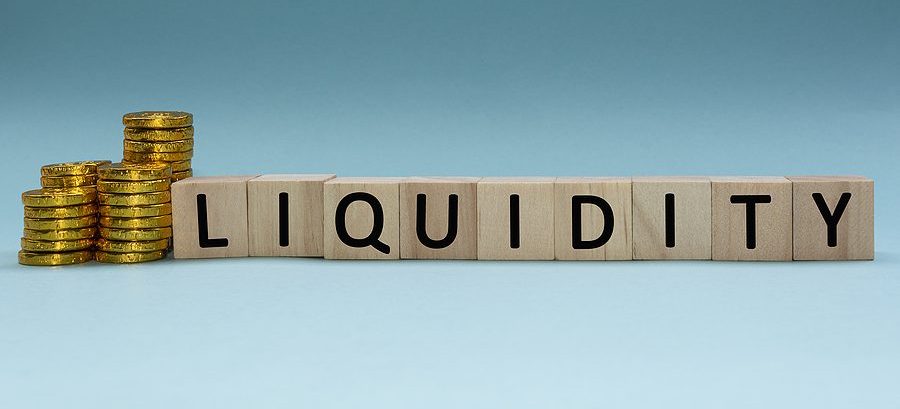CFGMS Admin September 15, 2021 Categories: Small Business Funding, Working Capital Financing
When it comes to evaluating the financial health of your business, liquidity is a key indicator. Every business owner should understand all the factors that affect liquidity and be able to determine the liquidity of their business. If this key indicator is ignored, then there is the potential for liquidity risk. Let’s start by defining liquidity and explaining the factors that impact it.
What is Business Liquidity?
Business liquidity is a company’s ability to meet its payment obligations. Business owners should be able to determine whether their business could meet all of its financial obligations should they come due at the same time within the normal operating cycle.

Influencing Factors
The three main factors impacting business liquidity are working capital management, risk management, and cash flow forecasting. Businesses can improve their liquidity by incorporating strong internal controls to manage these three key areas.
Working Capital Management
Working capital management is the process of managing the short-term operating assets and liabilities of a company. Businesses can improve their liquidity by maximizing sales while minimizing lead times, managing accounts receivable to reduce bad debt, invoice factoring to get paid faster for services rendered, and utilizing cash flow forecasts.
Risk Management
Risk management is the process of evaluating the potential for losses on a business function, investment, or an entire portfolio. Businesses can improve their liquidity by understanding and managing the risk associated with their cash flow forecasting models
Cash Flow Forecasting
Cash flow forecasting is defined as projecting future cash receipts and disbursements based on specific events. These include anticipated sales or financing needs to determine if adequate funding will be available at all times under projected conditions. Business owners should consider all factors that may affect their business before relying heavily on this key indicator for measuring liquidity.
What is Liquidity Risk?
Liquidity risk is when a company encounters difficulty in meeting obligations associated with financial liabilities. Business owners should be conscious of avoiding common pitfalls such as delayed payments, over-reliance on credit terms, inflexible payment terms, and not anticipating future cash flow fluctuations. Businesses can improve their liquidity by forecasting future cash flows before making capital investments or signing long-term contracts.
How to Determine Business Liquidity
The best way to determine the liquidity of your business is to evaluate your liquidity ratio. There are a few ways to do this.
Current or Working Capital Ratio
The current or working capital ratio is determined by dividing the net current assets by the company’s total current liabilities. Businesses with a high current ratio are typically liquid and have plenty of cash on hand to satisfy their short-term financial obligations. Those with low ratios will typically not meet their short-term financial obligations without an alternate source of funding.
Acid-Test or Quick Ratio
The acid-test or quick ratio is determined by dividing the net current assets minus inventories by a company’s total current liabilities. Businesses that have high acid test ratios have enough cash and other liquid assets to meet their short-term obligations without having to sell inventory. Those with low ratios may be forced to sell off assets to pay their creditors, decreasing the financial health of the business.
Cash Ratio
The cash ratio is determined by dividing the company’s total quick assets by its current liabilities. Businesses that have high ratios can meet their short-term financial obligations using only cash on hand and do not need to rely on other sources of funding. Those with low ratios need to utilize alternative forms of financing to pay off all of their creditors. If not done responsibly, this could impact the long-term viability.
Liquidity Ratio Rule of Thumb
Business owners should aim for a liquidity ratio that is greater than 1:1. This means that a company has sufficient liquid assets available at all times to cover its short-term obligation without having to sell inventory or other fixed assets to pay off debtors and avoid bankruptcy.
So, how do you get your business liquidity number?
Calculating Your Liquidity Ratio
To get your business liquidity ratio, you need to determine your current assets and liabilities.
Current Assets
Current assets are all of the business assets you expect to sell or use during normal business operations over the next year. These include cash, cash equivalents, accounts receivable, stock inventory, marketable securities, pre-paid liabilities, and other liquid assets.
Current Liabilities
Current liabilities are the accounts payable that a business owes to its suppliers, creditors, and others due to normal business operations. A business can have both short-term and long-term current liabilities. Current liabilities include accounts payable, accrued expenses payable, interest payable, mortgage payable/rent due within one year, taxes payable within one year, dividends payable within one year, and unearned revenue within one year.
Now You’re Ready to Calculate
To get your liquidity ratio, you divide your total current assets by your total current liabilities. Doing this will give you how many times you can cover all your creditors if they came knocking all at once demanding payment.
While the formula for each of the ratios previously mentioned is similar, what each considers current assets differ. The formula for the current or working capital ratio is the simplest while the other two options are more conservative.
Current assets divided by current liabilities equals your liability ratio. So if your current assets are $200,000 and your current liabilities are $150,000, your liquidity ratio would be 1.33.
For the acid-test or quick ratio, the equation remains the same. However, the current inventory is excluded from current assets. Let’s say you have $21,000 in inventory. You would then divide 179,000 by $150,00 for a liquidity ratio of 1.19.
With the cash ratio, both inventory and accounts receivable are excluded from current assets. If you have $11,000 in accounts receivable, you divide $167,000 by $150,000 for a liquidity ratio of 1.11.
When calculating business liquidity, if the ratio is less than one it means that if everybody who owed you money called today and asked for their money back that you would not be able to pay them. If your liquidity ratio is less than one, you should consider selling off some of their inventory or securing a source of additional cash flow to improve their liquidity ratios.

Improve Business Liquidity with CFG Merchant Solution™
At CFG Merchant Solutions™, we are a team of knowledgeable and experienced direct funders. We offer various funding options to help increase your cash flow and boost business liquidity. Our focus is on assisting small and mid-sized businesses that have historically been underserved by traditional financial institutions. Contact us today or apply online.
